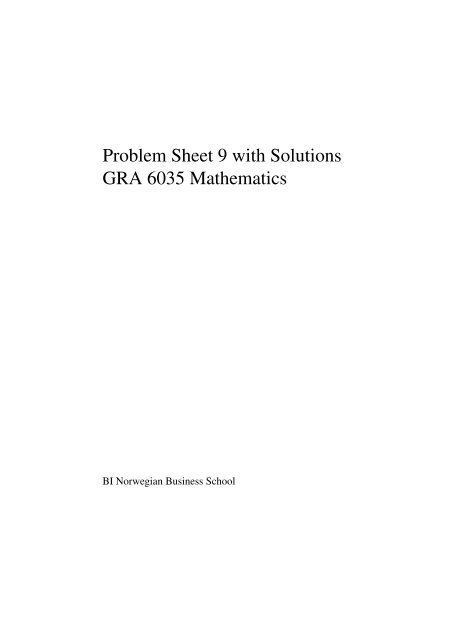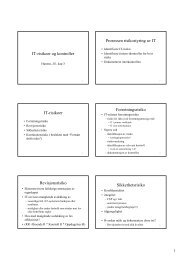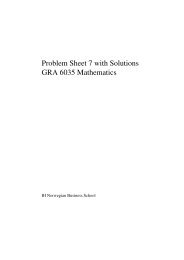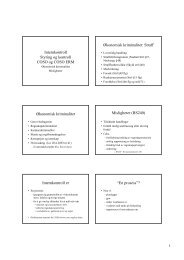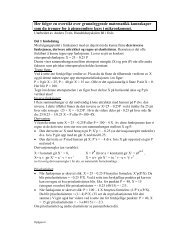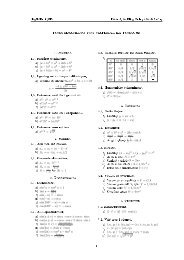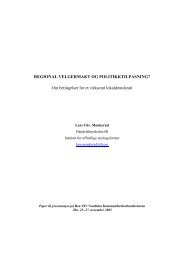Problem Sheet 9 with Solutions GRA 6035 Mathematics
Problem Sheet 9 with Solutions GRA 6035 Mathematics
Problem Sheet 9 with Solutions GRA 6035 Mathematics
Create successful ePaper yourself
Turn your PDF publications into a flip-book with our unique Google optimized e-Paper software.
<strong>Problem</strong> <strong>Sheet</strong> 9 <strong>with</strong> <strong>Solutions</strong><strong>GRA</strong> <strong>6035</strong> <strong>Mathematics</strong>BI Norwegian Business School
2<strong>Problem</strong>s1. Maximize the functionsubject to g(x 1 ,x 2 ) = x 2 1 + x2 2 ≤ 1.f (x 1 ,x 2 ) = x 2 1 + x 2 2 + x 2 − 12. Solve max (1 − x 2 − y 2 ) subject to x ≥ 2 and y ≥ 3 by a direct argument and thensee what the Kuhn-Tucker conditions have to say about the problem.3. Solve the following problem (assuming it has a solution):min 4ln(x 2 + 2) + y 2 subject to x 2 + y ≥ 2,x ≥ 14. Mock Final Exam in <strong>GRA</strong><strong>6035</strong> 12/2010, 4We consider the following optimization problem: Maximize f (x,y,z) = xy+yz−xzsubject to the constraint x 2 + y 2 + z 2 ≤ 1.a) Write down the first order conditions for this problem, and solve the first orderconditions for x,y,z using matrix methods.b) Solve the optimization problem. Make sure that you check the non-degenerateconstraint qualification, and also make sure that you show that the problem has asolution.5. Final Exam in <strong>GRA</strong><strong>6035</strong> 10/12/2010, 4We consider the function f (x,y,z) = xyz.a) The function g is defined on the set D = {(x,y,z) : x > 0,y > 0,z > 0}, and it isgiven by1g(x,y,z) =f (x,y,z) = 1xyzIs g a convex or concave function on D?b) Maximize f (x,y,z) subject to x 2 + y 2 + z 2 ≤ 1.
3<strong>Solutions</strong>1 The Lagrangian isand the Kuhn-Tucker conditions areandL (x) = x 2 1 + x 2 2 + x 2 − 1 − λ(x 2 1 + x 2 2 − 1),L ′1 = 2x 1 − 2λx 1 = 2x 1 (1 − λ) = 0L ′2 = 2x 2 + 1 − 2λx 2 = 2x 2 (1 − λ) + 1 = 0λ ≥ 0 and λ = 0 if x 2 1 + x 2 2 < 1.From L 1 ′ = 0 we obtain 2x 1(1 − λ) = 0. Thus x 1 = 0 or λ = 1. If λ = 1, thenL 2 ′ = 2x 2 + 1 − 2x 2 = 1 ≠ 0, so we conclude that x 1 = 0.CASE x1 2 + x2 2 = 1 :From x1 2 + x2 2 = 1 and x 1 = 0 we obtain x2 2 = 1 or x 2 = ±1. We have L 2 ′ =2x 2 (1 − λ) + 1 = ±2(1 − λ) + 1 = 0 =⇒ (1 − λ) =±2 −1 = ∓ 1 2 =⇒ λ = 1 ± 1 2 .Thus(0,−1) corresponding to λ = 1 2 and(0,1) corresponding to λ = 3 2are candidates for maximum.CASE x1 2 + x2 2 < 1 :From x 1 = 0 we get x2 2 < 1. This is the same as to say −1 < x 2 < 1. Since λ = 0,L 2 ′ = 2x 2 + 1 = 0 gives x 2 = −2 1 . We conclude thatis a candidate for maximum. We compute(0,− 1 ) corresponding to λ = 02f (0,1) = 1f (0,−1) = −1 andf (0,− 1 2 ) = −5 4and conclude that f (0,1) = 1 is the maximal value.2 See answers in FMEA (Exercise 3.5.1)3 We will use the following general method of solving
4⎧⎪⎨ g 1 (x 1 ,...,x n ) ≤ b 1max f (x 1 ,...,x n ) subject to..⎪⎩g m (x 1 ,...,x n ) ≤ b mby applying the following steps:a) L = f − λ 1 g 1 − ··· − λ m g mb) L 1 ′ = 0,L 2 ′ = 0,...,L n ′ = 0 (FOC’s)c) λ j ≥ 0 and λ j = 0 if g j (x 1 ,...,x n ) < b jd) Require g j (x 1 ,...,x n ) ≤ b jTo transform the problem into this setting, we definef (x,y) = −(4ln(x 2 + 2) + y 2 )since minimizing 4ln(x 2 + 2) + y 2 is the same as maximizing −(4ln(x 2 + 2) + y 2 ).We also rewrite the constraints asWe define the Lagrange function:g 1 (x,y) = −x 2 − y ≤ −2g 2 (x,y) = −x ≤ −1L = −(4ln(x 2 + 2) + y 2 ) − λ 1 (−x 2 − y) − λ 2 (−x)The first order conditions are the= −4ln(x 2 + 2) − y 2 + λ 1 (x 2 + y) + λ 2 xL 1 ′ 1= −4x 2 + 2 · 2x + 2λ 1x + λ 2 = −8xx 2 + 2 + 2λ 1x + λ 2 = 0L 2 ′ = −2y + λ 1 = 0Since there are two constraints, there are four cases to consider:The case −x 2 − y = −2 and −x = −1 :Since x = 1, we deduce from L ′1 = 0 that−8 · 11 2 + 2 + 2λ 1 · 1 + λ 2 = 0 ⇐⇒ 2λ 1 + λ 2 − 8 3 = 0From x 2 + y = 2 and x = 1 we obtain that y = 1. From L 2 ′ = −2y + λ 1 = 0 we theobtain that λ 1 = 2. Substituting this into 2λ 1 + λ 2 − 8 3= 0 we get2 · 2 + λ 2 − 8 3 = 0 ⇐⇒ λ 2 = − 4 3 < 0
This violates the complementary slackness conditions that says that λ 2 ≥ 0 sincethe second constraint is active. We conclude that the case case −x 2 − y = −2 and−x = −1 does not lead to a solution.The case −x 2 − y = −2 and −x < −1 :Since the second constraint is inactive, we get λ 2 = 0. Substituting this into−8xx 2 +2 + 2λ 1x + λ 2 = 0 we getSince x > 1 this gives−8xx 2 + 2 + 2λ 1x = 0 ⇐⇒ 2x(λ 1 − 4x 2 + 2 ) = 0λ 1 = 4x 2 + 2From −x 2 −y = −2 we have that y = 2−x 2 and substituting this and λ 1 = 4x 2 +2 into−2y + λ 1 = 0 gives−2(2 − x 2 ) + 4x 2 + 2 = 0 ⇐⇒ (x2 + 2)(x 2 − 2) + 2 = 0 ⇐⇒ x 4 = 2From this we obtain thatSince x > 1 we get thatFrom y = 2 − x 2 we obtainand from λ 1 = 2y we getx = ± 4√ 2 ∼ = ±1.1892x = 4√ 2y = 2 − √ 2λ 1 = 2(2 − √ 2)Thus we have the following candidate for optimum( 4√ 2,2 − √ 2) ←→ λ 1 = 2(2 − √ 2),λ 2 = 05The case −x 2 − y < −2 and −x = −1 :Since the first constraint is inactive, we get λ 1 = 1. Substituting this into −2y +λ 1 = 0 we gety = 0.Since x = 1 by assumption, we see that −x 2 − y = −1 which is not less that −2 sothe first constraint is not satisfied. Thus the case −x 2 − y < −2 and −x = −1 doesnot give any solution
6The case −x 2 − y < −2 and −x < −1 :Since both constraints are inactive, we get λ 1 = 0 and λ 2 = 0. Thus we get from−2y + λ 1 = 0 thaty = 0and from −8xx 2 +2 + 2λ 1x + λ 2 = 0 thatx = 0But −x = 0 is not less that −1, so this gives no solutions.Conclusion:The minimum value (subject to the constraints) is given by(x,y) = ( 4√ 2,2 − √ 2) =⇒ 4ln(x 2 + 2) + y 2 = 4ln( √ 2 + 2) + (2 − √ 2) 2 ∼ = 5.25494 Mock Final Exam in <strong>GRA</strong><strong>6035</strong> 12/2010, <strong>Problem</strong> 4See handwritten solution on the coarse page for <strong>GRA</strong> <strong>6035</strong> <strong>Mathematics</strong> 2010/11.5 Final Exam in <strong>GRA</strong><strong>6035</strong> 10/12/2010, <strong>Problem</strong> 4a) The Hessian of f is indefinite for all (x,y,z) ≠ (0,0,0) since it is given by⎛f ′′ = ⎝ 0 z y ⎞z 0 x⎠y x 0and has principal minors −z 2 ,−y 2 ,−x 2 of order two. Hence f is not convex or concave.We compute the Hessian of g, and find⎛g ′′ = 1 ⎜⎝xyzHence the leading principal minors are⎞2 1 1x 2 xy xz1 2 1 ⎟xy y 2 yz ⎠1 1 2xz yz z 2D 1 = 1 2xyz x 2 > 0, D 2 = 1 3(xyz) 2 (xy) 2 > 0, D 3 = 1 4(xyz) 3 (xyz) 2 > 0This means that g is convex.b) The set {(x,y,z) : x 2 + y 2 + z 2 ≤ 1} is closed and bounded, so the problem hassolutions by the extreme value theorem. The NDCQ is satisfied, since the rankof ( 2x 2y 2z ) = 1 when x 2 + y 2 + z 2 = 1. We form the Lagrangian
7L = xyz − λ(x 2 + y 2 + z 2 − 1)and solve the Kuhn-Tucker conditions, consisting of the first order conditionsL ′x = yz − λ · 2x = 0L ′y = xz − λ · 2y = 0L ′z = xy − λ · 2z = 0together <strong>with</strong> one of the following conditions: i) x 2 + y 2 + z 2 = 1 and λ ≥ 0 orii) x 2 + y 2 + z 2 < 1 and λ = 0. We first solve the equations/inequalities in casei): If x = 0, then we see that y = 0 or z = 0 from the first equation, and we getthe solutions (x,y,z;λ) = (0,0,±1;0),(0,±1,0;0). If x ≠ 0, we get 2λ = yz/xand the remaining first order conditions give (x 2 − y 2 )z = 0 and (x 2 − z 2 )y = 0.If y = 0, we get the solution (±1,0,0;0). Otherwise, we get x 2 = y 2 = z 2 , hence((x,y,z;λ) = ± √ 1 ,± √ 1 ,± √ 1 ;± 1 )3 3 3 2 √ 3The condition that λ ≥ 0 give that either all three coordinates (x,y,z) are positive,or that one is positive and two are negative. In total, we obtain four differentsolutions. We note that f (x,y,z) = 13 √ for each of these four solutions, while3f (x,y,z) = 0 for either of the first three solutions. Finally, we consider case ii),where λ = 0. This gives xy = xz = yz = 0, and we obtain(x,y,z;λ) = (a,0,0;0),(0,a,0;0),(0,0,a;0)The condition that x 2 + y 2 + z 2 < 1 give a 2 ≤ 1 or a ∈ (−1,1). For all thesesolutions, we get f (x,y,z) = 0. We can therefore conclude that the solution to theoptimization problem is a maximum value of13 √ 3


